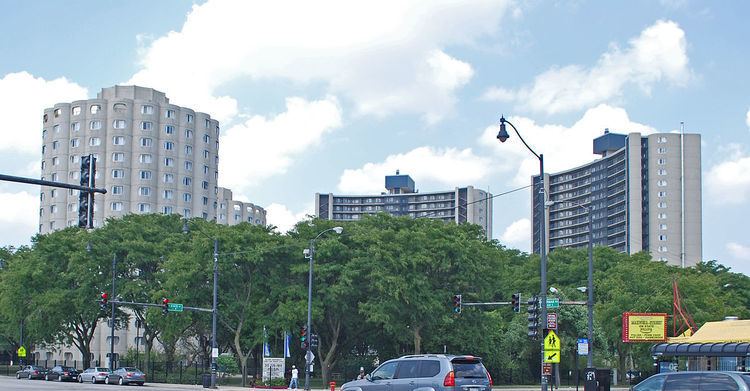Built 1966 (1966) NRHP Reference # 99001072 Phone +1 312-225-6691 | Architectural style Modern Movement Opened 1966 Added to NRHP 13 September 1999 | |
 | ||
Address 54 W Cermak Rd, Chicago, IL 60616, USA Similar River City, Heyworth Building, Powhatan Apartments, Brooks Building, New York Life Insurance | ||
Hilliard Towers Apartments, formerly known as the Raymond Hilliard Homes CHA housing project, is a residential high-rise development in the near South Side of Chicago, Illinois. It was designed by Bertrand Goldberg and is located between Clark Street, State Street, and Cermak Road. In 1999, it was placed on the National Register of Historic Places as the Raymond M. Hilliard Center Historic District.
Contents
Historical background
The Hiliard Towers are built on top of what was once The Levee, a "wide-open" urban district on the South Side of Chicago. Close to railroad stations and railroad yards, the district was informally set aside for purposes of organized prostitution until its closure in the 1910s. The shutdown of the Levee was spurred by a citywide crusade against human trafficking.
Construction
Design began in 1963, with the increasing demand for affordable public housing and urban renewal projects growing in popularity throughout the country. Goldberg designed the structure to be supported almost exclusively by the outer shell, as opposed to Marina City, which was supported by its core. His opinion of other public housing projects was that they were developed in such a way as to punish residents for being poor; Goldberg wanted to design a home that residents would be proud of. Residents were vetted carefully and as a result, crime and social problems at Hilliard Homes were considerably lower than at other CHA housing projects. It was the only project never to require a uniformed police detail. The twin cylindrical towers were reserved for seniors and the two adjoining half-circle buildings were reserved for low-income families.
Redevelopment
By the early 1990s, the buildings had fallen into disrepair. In 1997, the CHA initiated a process of financing and redevelopment that would span 9 years, ending in 2006. The property is currently mixed-income, with a combination of middle-class residents paying market rate, plus low-income families and senior citizens with Section 8 vouchers.
